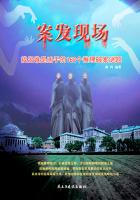The first result of the attempt to use the schools as an instrument of reconstruction ended in the ruin of several state universities.The faculties of the Universities of North Carolina, Mississippi, and Alabama were made radical and the institutions thereupon declined to nothing.The Negroes, unable to control the faculty of the University of South Carolina, forced Negro students in and thus got possession.In Louisiana the radical legislature cut off all funds because the university would not admit Negroes.
The establishment of the land grant colleges was an occasion for corruption and embezzlement.
The common schools were used for radical ends.The funds set aside for them by the state constitutions or appropriated by the legislatures for these schools seldom reached their destination without being lessened by embezzlement or by plain stealing.Frequently the auditor, or the treasurer, or even the legislature diverted the school funds to other purposes.Suffice it to say that all of the reconstruction systems broke down financially after a brief existence.
The mixed school provisions in Louisiana and South Carolina and the uncertainty of the educational situation in other States caused white children to stay away from the public schools.For several years the Negroes were better provided than the whites, having for themselves both all the public schools and also those supported by private benevolence.In Mississippi, Louisiana, and South Carolina the whites could get no money for schoolhouses, while large sums were spent on Negro schools.The Peabody Board, then recently inaugurated,* refused to cooperate with school officials in the mixed school states and, when criticized, replied: "It is well known that we are helping the white children of Louisiana as being the more destitute from the fact of their unwillingness to attend mixed schools."* To administer the fund bequeathed by George Peabody of Massachusetts to promote education in the Southern States.See "The New South", by Holland Thompson (in "The Chronicles of America").
As was to be expected, the whites criticized the attitude of the school officials, disapproved of the attempts made in the schools to teach the children radical ideas, and objected to the contents of the history texts and the "Freedmen's Readers." A white school board in Mississippi, by advertising for a Democratic teacher for a Negro school, drew the fire of a radical editor who inquired: "What is the motive by which this call for a 'competent Democratic teacher' is prompted? The most damning that has ever moved the heart of man.It is to use the vote and action of a human being as a means by which to enslave him.The treachery and villainy of these rebels stands without parallel in the history of men."A Negro politician has left this account of a radical recitation in a Florida Negro school:
After finishing the arithmetic lesson they must next go through the catechism:
"Who is the 'Publican Government of the State of Florida?" Answer: "Governor Starns.""Who made him Governor?" Answer: "The colored people.""Who is trying to get him out of his seat?" Answer: "The Democrats, Conover, and some white and black Liberal Republicans.""What should the colored people do with the men who is trying to get Governor Starns out of his seat?" Answer: "They should kill them."....
This was done that the patrons, some of whom could not read, would be impressed by the expressions of their children, and would be ready to put any one to death who would come out into the country and say anything against Governor Starns.
The native white teachers soon dropped out of Negro schools, and those from the North met with the same social persecution as the white church workers.
The White League and Ku Klux Klan drove off obnoxious teachers, whipped some, burned Negro schoolhouses, and in various other ways manifested the reaction which was rousing the whites against Negro schools.
The several agencies working for Negro education gave some training to hundreds of thousands of blacks, but the whites asserted that, like the church work, it was based on a wrong spirit and resulted in evil as well as in good.
Free schools failed in reconstruction because of the dishonesty or incompetence of the authorities and because of the unsettled race question.It was not until the turn of the century that the white schools were again as good as they had been before 1861.After the reconstruction native whites as teachers of Negro schools were impossible in most places.The hostile feelings of the whites resulted and still result in a limitation of Negro schools.The best thing for Negro schools that came out of reconstruction was Armstrong's Hampton Institute program, which, however, was quite opposed to the spirit of reconstruction education.













